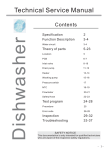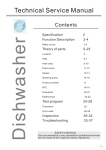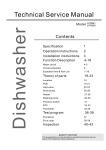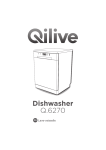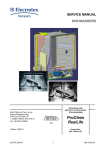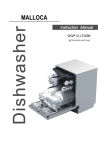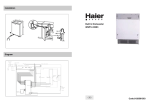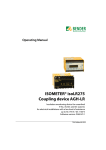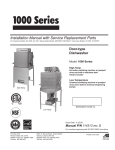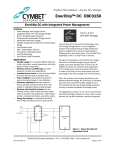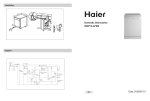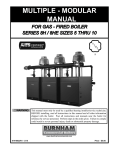Download service manual (template E4)D
Transcript
Technical Service Manual Dishwasher Contents Specification Function Description 2 3-4 Water circuit 3-4 Theory of parts 5-23 Location 5 PCB 6-7 Inlet valve 8-10 Drain pump 11-12 Heater 13-14 Washing pump 15-16 Pressure switch 17 NTC 18-19 Flowmeter 20-21 Safety Hose 22-23 Diverter valve 24 Test program 25-29 Procedure 26 Error code 27-29 Inspection Troubleshooting 30-33 34-38 SAFETY NOTICE This documentation is only intended for qualified technicians who are aware of the respective safety regulations. - 1- Specifications Models: WQP12-J7225 Electrical supply 220-240V, 50Hz Supply water pressure 0.04MPa-1.0MPa Supply water temperature below 60℃ For the basic operation instructions, please refer to the instruction manual attached with each unit. - 2- Water circuit scheme Cycle water route Drain water route Inlet water route Water Circuit -> Function Description - 3- Water Circuit -> Function Description Process of water inlet (indicated by magenta route) In this process, regeneration water route is cut off, main water route is open. The water in the main water route is softened when pass through the softener, and then enter in the tub. During this phase, some of inlet water will be stored in the air breaker to be regenerating water. Process of cycle washing (indicated by blue route) Cycle washing action is driven by washing pump motor. Water can obtain the power during it passing through the working washing pump, then be pumped into spray arm, pass from spray arm nozzles, over the dishes, into sump ,where connect to washing pump, and to get in the next water cycle. - 4- Location -> Theory of parts air breaker heater main PCB drain pump softener pressure switch sump washing pump Please Note: Explode view and part list of each model have some different visions. So please refer to the newest vision Midea sent you - 5- PCB -> Theory of parts PCB Printed Circuit Board is the control center of dishwasher, which receive and process signal from components, send order to components and deal with the feedback information, etc. Access PCB Removing the protecting box. The PCB can be removed from the protecting box in the bottom of machine. 1. Disconnect power supply; 2. Take out cutlery basket, basket and filter system; 3. Open the cover of bottom board. 4. Remove the screws for fixing protecting box and open the protecting box cap. - 6- protecting box screw Bottom view 5. Disconnect the connector form PCB. 6. Remove the screws securing the PCB to control panel. 7. Remove the PCB. 8. Reverse the above procedure to install. - 6- PCB -> Theory of parts View of PCB Note: This map is applies to 7201 model. Note: This map is applies to 7207A model. - 7- PCB -> Theory of parts Description Mark HEAT ACL ACN EV-L RE ML PS D/ED EV1 EV2 EV3 ISS ISB IAQS FM FAN Function Output for Heating Element Input of line Input of neutral Input of inlet valve Thermister Washing Pump Drain Pump Dispenser Inlet valve Softener Halfload Valve Salt detect Rinse detect Overflow detect Flowmeter Fan There is small pole’s location difference between different models. But the marks on PCB have the same meaning described on the left side . - 8- Inlet Valve -> Theory of parts Location of inlet valve Bottom view Appearance terminals connect to inlet water hose to air breaker electric coil inside The work principle The inlet valve is electromagnetic valve that decide whether water enter or not. Valves are normally closed. Each time the appliance requires water, the controller will convey an electric signal to the coils to open the valves. The inlet valve consist of electric coil, valve body, valve pole, filter etc. In a word, the electromagnetic valve can act to allow water enter into machine, when it receive the order given by controller. The defeat point 1. The valve coil is broken, so the valve can’t open. It will cause the E1 error. 2. The filter is jammed, so water can’t enter. It will cause the E1 error. 3. The connector is loose, so the valve can’t open. It will cause the E1 error. 4. The valve pole is rusted or locked by dreg, so the valve can’t open or close. It will cause the E1 or E4 error. Technical data Nominal voltage Frequency Resistance Work duty Flux Power Work Pressure 220-240VAC 50/60Hz Approx:3.4-4.4kΩ 100%ED T25 3min/5min T60 2.5L/min 15% 5W 0.04-1MPa - 9- Inlet Valve -> Theory of parts Access inlet valve 1. Disconnect power. 2. Remove the water inlet hose. (Note : Be careful of remain water drop.) 3. Remove the cover of the bottom board. 4. Disconnect the 2 terminal lugs from the inlet valve. 5. Pull out the valve a little then contrarotate it to take it off. 6. Remove the clamp and disconnect the inlet hose (to air breaker) from the water valve. 7. Reverse above procedures to install. Inspect inlet valve Check electric part 1.Open the protecting box and take out the PCB; 2.With the door closed, unplug the CON3 and ACN wires , then use the multi-meter Ω shelf to measure resistance between the blue wire (EV1) and the blue wire(ACN), the normal resistance is about 3.4K Ω to 4.4K Ω . 3. I f the measured resistance is not correct, it means the valve coil is broken or the connector is loose. In this case, we should check the connection first. If the problem hasn’t been solved by re-connection, we should replace the valve.. 4.If the resistance is OK, we need to inspect the valve body. EV1 ACN Check machine part 1. If the electric part is OK, we need to check the machine part. 2. Check the valve filter. if the valve filter is blocked, we need clear the residues. 3. If the valve filter is clear and the valve can’t inlet water, check whether valve can act or not. If it isn’t , we need replace the valve. 4. If the water is continue entering, we need replace the valve. - 10 - Drain Pump -> Theory of parts Location of Drain Pump The work principle Bottom view Drain pump integrated into sump The work principle Drain pump consists of electrical motor, impeller, inlet and outlet. Drain pump is a kind of pump driven by permanent magnet synchronous motor. The rotor is made with permanent magnet material, the running inertia of rotor is very small, the stator consist of silicon steel stack and coil. When the drain pump is on power, the rotor will be very easy to start. The defeat point 1. The motor coil is broken, so the drain pump can’t work. It will cause the E2 , E4 or E1 error . 2. The magnetism of motor rotor is weak, so drain pump cannot work. It will cause the E2, E4 or E1 error . 3. The connector is loose, so the drain pump can’t work. It will cause the E2, E4 or E1 error . 4. The rotor is locked by residues, so the drain can’t work . It will cause the E2, E4 or E1 error . 5.The drain pump assembly rack is loose, it will cause noise. 6.The non-return valve is bad, the remain water is too much. Explanatory notes: failure of drain pump may cause E1, becaus Technical data Nominal voltage Frequency Resistance Delivery height Delivery performance 220-240VAC 50Hz 167 10%Ω 1M ≥17l/min(230VAC) - 11 - Drain Pump -> Theory of parts Access drain pump Top 1. Drain off the water in the dishwasher, and disconnect the power supply。 (Note : Make sure to remove remained water in the dishwasher. If not, wet the floor.) 2.Loosen the hooks, and then remove bottom board.(Note:You should first loosen the top hooks, then the left and right hooks. and be care do not break the hook.) 3. Label and disconnect the two terminal lugs from the drain pump. 4. Contrarotate the drain pump to take it off. 5. Reverse the above procedure to install. Inspect drain pump Check the electric part 1.Open the protecting box and take out the PCB; 2.With the door closed,unplug the CON3 and ACN wires, then use the multi-meter Ω shelf to measure the red wire (PS) and blue wire (ACN), the normal resistance is about 150 Ω to 190 Ω . 3. If the measured resistance is not correct, it means the pump coil is broken or connector is loose. In this case, we should check the connection first. If the problem hasn’t been solved by re-connection, we should replace the drain pump. 4.If the resistance is OK, but it also can’t work, maybe the magnetism is too weak, so we need to replace the drain pump. PS ACN Check the machine part 1. If the electric part is OK, we need to check the machine part. 2. Remove bottom board. 3. If the non-return valve is wrongly assembled, the tub will remain much water. We need to re-assemble the non-return valve. 4. If the drain pump is working, but no water drain out or just a little. We should check the drain hose or drain body. - 12 - Heater -> Theory of parts Location of Heater The work principle Bottom view fuse pressure switch Technical data Nominal voltage Rating power Resistance Fuse 230VAC 1800W 29.4 10%Ω 167℃ The defeat point 1. The heater coil is broken, so the heater cannot work. It will cause the E3 error. 2. The Fuse is active, so the heater cannot work. It will cause the E3 error. 3. The connector is loose, so the heater cannot work. It will cause the E3 error. - 13 - Heater -> Theory of parts Access heater 1. Drain off the water in the dishwasher, and disconnect the power supply. (Note : Make sure to remove remained water in the dishwasher. If not, wet the floor) 2. Remove bottom board. 3. Label and disconnect the terminals. 4. Remove the 3 screws for fixing the heating element. 5. Reverse above procedures to install. Inspect heater 1. Remove bottom board. 2. With the door closed,use the multi-meter Ω shelf to measure resistance between the two terminals shown in above right picture, the resistance is about 29 Ω to 31 Ω . 3. If the measured resistance is not correct, it means the heater coil or the thermostat is broken, we should replace the heating element or the thermostat. - 14 - Washing Pump -> Theory of parts Location of Washing Pump B ottom View The work principle BLUE BLUE M RED A 150℃ BLACK M-main coil A-assistant coil Washing pump is a kind of asynchronism motor with capacitor. The stator consist of silicon steel stack and two coils, main coil and assistant coil . The defeat point 1. The motor coil is broken, so the wash pump can’t work. It will cause E3 error. 2. The motor rotor capacitor is weaken, so washing pump can’t start. In this case, it will send out the electromagnetism noise. If it is continue electrifying motor, the thermal protector will work. It will cause E3 error. 3. The connector is loose, the wash pump can’t work. It will cause E3 error. 4. The rotor is locked by residues, so the wash pump can’t work . It will cause the E3 error. 5.The drain pump assembly bracket is loose, it will cause noise. 6.If the machine hasn’t been used for long time, there is a possibility the wash pump can’t starting. Technical data Models YXW48-2F-1 Items Nominal voltage 220-240VAC Frequency 50Hz Main coil: 159.4 10%Ω Resistance Assistant coil:93.3 10%Ω Delivery height 1m Delivery ≥50l/min(230VAC) performance Lock rotor 0.5A 10% current Operating 0.24A 15% current Capacitor 3μF /425V YXW48-2F 220-240VAC 50Hz Main coil:120.10 7%Ω Assistant:107.7 7%Ω 1m(230VAC) ≥50l/min(230VAC) 0.85A 10%(230VAC) 0.37A 10%(230VAC) 3μF/425V - 15 - Washing Pump -> Theory of parts Access Washing Pump 1. Disconnect power. 2. Remove bottom board. 3. Label and disconnect the 2 terminals to the motor wire connector. 4. Remove the clamp fastening the interconnect hose to the sump. Caution: The clamp is easily damaged during removal and can’t be reused. Replace the old clamp with a new universal clamp. 5. Disconnect the ground wire from the wash pump motor assembly. 6. Remove the motor pump assembly from the dishwasher. 7. Reverse above procedures to install. Inspect Washing Pump Check the electric part 1.Open the control panel and take out PCB; 2.With the door closed, unplug the CON5 , then use the multi-meter Ω shelf to test resistance between two wires (ML and ACN), the normal resistance is about 100 Ω to 170 Ω . 3. I f the resistance is not correct, it means the pump coil is broken or the connector is loose, In this case, we should check the connection first. If the problem hasn’t been solved by re-connection, we would replace the washing pump. 4.If the resistance is OK but it cannot work, it maybe the capacitor weakly, we need to replace the capacitor. ML ACN Check the machine part 1. If the electric part is OK, we need to check the machine part. 2. Remove bottom board. 3. Check the pump assembly, if the bracket is loose, it will bring the noise, we need to tighten it. 4. If the wash pump cannot start and the machine hasn’t been used too long, maybe the seal element is bond. 5. If the drain pump is working, but no water out or just a little. We should check the vane wheel. - 16 - Pressure Switch -> Theory of parts The work principle The pressure switch consists of a moving diaphragm and disc which activate a change over contact. The contact can be calibrated to trip and reset at the desired pressure levels, The main application is to control the level of water in appliances. May also provide flood protection. In our production, May also provide flood protection, like 135/115 serial. 1- COM 2 1 3 2 - NC 3 - NO Front view Back view - 17 - NTC -> Theory of parts Location of NTC The work principle Negative Temperature Coefficient Thermistor is integrated into sump, which is used for measuring temperature of water in the tub. Access NTC 1. Remove bottom board. 2. Remove two screws securing the NTC to sump(shown in above picture). 3. Take out NTC. 4. Reverse the above procedure to install. - 18 - NTC -> Theory of parts Inspect NTC 1.Open the protecting box and take out PCB; 2.With the door closed,unplug the RE connector(shown in below picture), then use the multi-meter Ω shelf to test resistance between two blue wires(RE and GND) , the normal resistance is shown in below table. 3. I f the resistance is not correct, it means NTC circuit has a problem. In this case, we should check the connection first. If the problem hasn’t been solved by re-connection, we would replace the NTC. GND RE NTC resistance table NTC 15℃ 20℃ 25℃ 30℃ 40℃ 50℃ 60℃ 70℃ 80℃ 85℃ 17.48KΩ 12.12KΩ 10KΩ 8.299KΩ 5.807KΩ 4.144KΩ 3.011KΩ 2.224KΩ 1.667KΩ 1.451KΩ - 19 - Flowmeter -> Theory of parts Location of Flowmeter The work principle Flowmeter is integrated into Air Breaker. Function of Flowmwter is measure how much water has entered in appliance. it consists of impeller, tongue tube and terminal, etc. When water pass through the flowmeter, moving water can rotate magnetic impeller, the tongue tube can sense the impeller’s magnetic and send electronic pulses. Flowmeter - 20 - Flowmeter -> Theory of parts Access Flowmeter 1. Remove the baseboard, top panel and left side panel. 2. Remove the plastic nut inside tub, which secures the air breaker to tub.(Because flowmeter is integrated into air breaker, replace air breaker if flowmeter has failure. ) 3. Disconnect the wire and remove clamp fastening hose to air breaker. 4. Take out air breaker. 5. Reverse the above procedure to install. Inspect Flowmeter 1.Open the protecting box and take out PCB; 2.With the door closed, unplug the CON2 wire(shown in below picture), then use the multi-meter Diode shelf to test between black wire(FM) and blue wire(GND) to confirm whether electrical pulse is sent out while water is passing through flowmeter, or not. 3. If there is continual electrical pulse, the multi-meter will send out sound “de” continually. 4.if there is no electrical pulse, the multi-meter will not send sound. In this case, it means something wrong with flowmeter circuit. We should check the connection first. If the problem hasn’t been solved by re-connection, we should replace the air breaker.. GND FM - 21 - Safety hose -> Theory of parts Location of Safety Hose Electronic Aquastop Hose The work principle Mechanical Aquastop Hose Electronic Aquastop Hose There are two types of Safety Hose, mechanical Aquastop hose and electronic Aquastop hose, which have different principles and assembly modes. Mechanical Aquastop safety hose has two layers. If water leak and fill the air space between two layers, the foaming material will expand and lock the hose. In this situation, the machine might set off E1 alarm. Electronic Aquastop safety hose also has two layers. But the difference from mechanical is that if the water leak and flow on the bottom tray, the flooding pressure switch on the tray will act, the electromagnetic valve on the hose will cut off the water road and the machine will set off E4 alarm. - 22 - Safety hose -> Theory of parts Access Safety Hose clamp wire co nnecter ( no nee d to di stinguish positive and ne gative elec trode) clamp r ing 1. Remove baseboard, side baseboard, top panel and left side panel. 2. Remove clamp, cut the bound belt and disconnect the wire connector. Then the Inlet hose cane pulled out. 3. Reverse the above procedure to assemble. Mechanical Aquastop Hose Mechanical Aquastop hose is connected to appliance just as universal water inlet hose. Inspect Safety Hose Electronic Aquastop Hose 1.Open the protecting box and take out the PCB; 2.With the door closed, unplug the CON3 and ACN wires , then use the multi-meter Ω shelf to measure resistance between the blue wire (EV1) and blue wire (ACN). Open circuit and short circuit are both incorrect. 3. I f the measured resistance is not correct, it means the valve coil is broken or the connector is loose. In this case, we should check the connection first. If the problem hasn’t been solved by re-connection, we should replace the safety hose. Mechanical Aquastop Hose Maybe moisture absorption of foaming material in mechanical device cause a self-lock fault(can’t fill the water) and this lock is non-resettable. - 23 - Diverter valve -> Theory of parts The work principle Diverter, also named alternating flow control valve, is used to control the flow of water between the upper and lower spray arms and can also be used on some models to stop the flow of water to the upper spray arm on models equiped with a half load feature. Access Diverter valve 1. Disconnect power. 2. Remove bottom board. 3. Label and disconnect the 2 terminals. 4. Remove the screws fastening the diverter valve to pump. 5. Reverse the above procedure to install. diverter valve - 24 - Test Program Test Program In order to check the operation of components of appliance and find out the malfunction, we designed this program for technician. How to activate Test Program Test Program Operation J7225 How to activate With door opened, Test Program Program + Power Start Test Program Jump into next step E1 Close the door Program E1 E2 / E3 E3 E4 E4 E6 E6 E7 E7 E8 E8 To activate test program, with the door opened and within 60s after power on, hold down the Program button and press the POWER button until the machine enter into Test Program. The appliance will pause and stand by(as step 00). Then close the door to start the Test Program. During test program running , you can press Program button to jump into next step ( except inlet valve step ). Note: The way to activate test program is slightly different between different models. - 25 - Procedure -> Test Program Procedure of Test Program (for models controlling water filling by flowmeter) No. Dis play on t he s c reen 0 8:88 1 05 or Turbidity value 2 Description Process Intialization Power on, stand by Inlet Valve Open inlet valve and feeds with 3.6L water. The diverter would move to positon rotating both upper and lower sprayarms. If the model is equipped with turbidity sensor, turbidity value would be adjusted and shown on the screen. Higher-speed 04/Temper- Washing Pump ature value and Heating Element Run higher-speed washing pump and 10s later run heating element until the water temperature reaches 57℃. Then the machine will pause. Press Program button to jump into the next step. Lower-speed 2s later run lower-speed washing pump for 8s, dispenser will act Washing Pump for 45s in this step. and Dispenser 3 03 4 02 5 01 Drain Pump 6 F* finish Regeneration Open regeneration valve for 30s. Valve Drain for 30s. Buzz one sound, stop, and stand by. - 26 - Error Code -> Test program How to know which error code has occurred To know which error code has occurred, refer to the previous table named Test Program Operation. Take 7201 for example, If the error 1 has happened, the buzzer would alarm for 30 seconds and “E1” would be shown on display. Other error alarms would be shown in the same manner. Take 7303 for example, if the error 7 has happened, the buzzer would alarm for 30 seconds and the Glass, 1 hour and Rapid indicators would flash simultaneously. Other error alarms can be deduced from this. The corresponding relation between indicator combination and error code shown in above figure. Notice: the majority of models are follow this regulation. Attention Priority level of E4 is the highest. E4 operation is valid after other error operations have done. When E4 operation has done, all the others are invalid. In test program, E1, E3, E4, E6, E7 and E8 are valid. Note: E8 is valid for models equipped with diverter valve(alternative washing function). - 27 - Error Code -> Test program How does the appliance react when error code occurred E1 Water filling exceed pre-set time If the inlet valve has been opened for 4 minutes but the water quantity hasn’t reached the desired value(measure by pluses), E1 would occur. When E1 occurs, the drain pump will run until flowmeter keep motionless for 2 minutes and all the other components will be stopped immediately. At the same time, the buzzer will alarm for 30 seconds and error 1 will be shown. E3 Heating exceed pre-set time If the heating element has been working for 60 minutes but the water temperature detected by NTC hasn’t reached desired value. E3 would occur. When E3 occurs, the drain pump will run until flowmeter keep motionless for 2 minutes. and all the other components will be stopped immediately. At the same time, the buzzer will alarm for 30 seconds and the error 3 will be shown. E4 Overflow At any time, if overflow micro-switch act and keep for longer than 2 seconds, the E4 would occur. When E4 occurs, the drain pump will run until flowmeter keep motionless for 2 minutes . and all the other components will be stopped immediately. At the same time, the buzzer will alarm for 30 seconds and error 4 will be shown. Note: Priority level of E4 is the highest. E4 operation is valid after other error operations have done. When E4 operation has done, all the others are invalid. E6 Open-circuit failure of thermistor In test program, once open-circuit failure of thermistor is detected by controller, the E6 would occur. When E6 occurs, the drain pump will run until flowmeter keep motionless for 2 minutes. and all the other components will be stopped immediately. At the same time, the buzzer will alarm for 30 seconds and error 6 will be shown. - 28 - Error Code -> Test program E7 Short-circuit failure of thermistor In test program, once short-circuit failure of thermistor is detected by controller, the E7 would occur. When E7 occurs, the drain pump will run until flowmeter keep motionless for 2 minutes . and all the other components will be stopped immediately. At the same time, the buzzer will alarm for 30 seconds and error 7 will be shown. E8 Diverter valve fault For models equipped with diverter(alternative washing function) In the process of test program in which diverter valve should be act, if machine doesn’t detect the feeding signal of diverter valve for 15 seconds or doesn’t detect the diverter valve being positioned accurately in 60 seconds, the E8 would occur. In the process of washing program in which diverter valve should be act, if machine doesn’t detect the feeding signal of diverter valve for 15 seconds or doesn’t detect the diverter valve being positioned accurately in 60 seconds, the diverter valve would stop and the E8 would be set off after ending washing program. When E8 occurs, the drain pump will run until flowmeter keep motionless for 2 minutes and all the other components will be stopped immediately. At the same time, the buzzer will alarm for 30 seconds and the error code will be shown. - 29 - E1 tree -> Inspection E1 code Longer inlet time Is there any water in the Tub? No water Make a check of inlet hose of AQUASTOP, (only for the dishwasher with AQUASTOP device) Failure Replace it to solve the problem Little water Make a check of Tap Not open Open it to solve the problem Opened Make a check of Inlet Hose Failure Inlet Hose is blocked or kinked Failure solve the problem OK Check whether the Inlet Valve circuit is correct or not. (mentioned in section 4) Not OK Reconnect the wire of Inlet Valve circuit and check again solve the problem Correct Still wrong Model with Flowmwter Model with Pressure Switch(83/63) Check whether the Pressure Switch(83/63) circuit is correct or not. Not Reconnect the wire of Pressure Switch circuit and check again OK solve the problem Still wrong Check whether the Flowmeter circuit is correct or not. (mentioned in section 4) Not Reconnect the wire of Flowmeter circuit and check again Lower Give advice to consumer OK Make a check of Drain Hose Wrong Hang correctly to solve the problem Replace the Pressure switch to solve problem OK Still wrong Make a check of the Hydraulic pressure. (0.04-1.0MPa is ok) Replace the Inlet Valve to solve problem solve the problem Replace the Flowmeter to solve problem If the problem has not been solved through all the inspection mentioned above, maybe the PCB has a malfunction. So, replace PCB and test again. - 30 - E3 tree -> Inspection E3 Longer heating time Check water temperature in the tub Low Make a check of over heat proof heating Micro-switch. Failure Replace Switch to solve the problem OK High Jammed Check whether the filter is jammed severely or not Clear or replace filter to solve the problem OK Make a check of Heater. (mentioned in section 4) Failure Reconnect the wire of Heater circuit and check again OK solve the problem Still wrong OK Check whether the Washing Pump circuit is correct or not. (mentioned in section 4) Not Reconnect the wire of Washing Pump circuit and check again OK Still wrong Check whether the NTC circuit is correct or not.(mentioned in section 4) Not Reconnect the wire of NTC circuit and check again Replace the Inlet Valve to solve problem solve the problem Replace the Washing Pump to solve problem OK solve the problem Still wrong Replace the NTC to solve problem - 31 - E4 tree -> Inspection E4 Overflow Is there any water on the bottom board? No water Make a check of Flooding Switch circuit(normally closed) Failure Reconnect the wire of Flooding Switch circuit and check again OK solve the problem Still wrong Some water Make sure consumer use the proper detergent and rinse Check whether Flooding Switch is blocked or not Blocked Repair or Replace it to solve problem Improper Give advice OK Make a check of Drain Hose Model with Pressure Switch(83/63) Failure Drain Hose is kinked or blocked Failure Not Reconnect the wire of Flowmeter circuit and check again OK Correct Solve the problem OK Model with Flowmeter Check whether the Flowmeter circuit is correct or not. (mentioned in section 4) solve the problem Still wrong Check whether the Pressure Switch(83/63) circuit is correct or not. Correct Not Reconnect the wire of Pressure Switch circuit and check again Replace the Flowmeter to solve problem OK Still wrong solve the problem Replace the Pressure Switch to solve problem Maybe there is a real leakage Do as follows Remove two side panels Remove the water from the bottom board and make sure there is no water at the bottom board. Restart the dishwasher with a strong or standard wash program as a leakage could easily repeat at a higher temperature and after a long period of running time. Observe the bottom tray every twenty minutes. If any water appears, you will found out which areas, such as motor, drain pump, sump, softener, and hoses between them, and also clips at the end of each hose, besides the weld seam at the bottom of the tub. If hours passed, but no water comes out, you should stop the dishwasher with sufficient water in the inner tub, and observe it again after leaving it alone for one to two hours. - 32 - E6&E7 tree -> Inspection E6 Open-circuit failure of thermistor Check whether the NTC circuit is correct or not. (mentioned in section 4) Not Reconnect the wire of Flowmeter circuit and check again OK solve the problem Still wrong Replace the NTC to solve problem E7 Short-circuit failure of thermistor Check whether the NTC circuit is correct or not. (mentioned in section 4) Not Reconnect the wire of Flowmeter circuit and check again OK solve the problem Still wrong Replace the NTC to solve problem E8 Diverter valve fault Check whether the Diverter Valve circuit is correct or not. (mentioned in section 4) Not Reconnect the wire of Diverter Valve and check again Still wrong OK solve the problem Replace the NTC to solve problem If the problem has not been solved through all the inspection mentioned above, maybe the PCB has a malfunction. So, replace PCB and test again. Caution: Because the real situation is unpredictable, inspection trees mentioned in this manual are for reference only. - 33 - Troubleshooting - 34 - Troubleshooting - 35 - Troubleshooting - 36 - Troubleshooting - 37 - Troubleshooting - 38 -






































